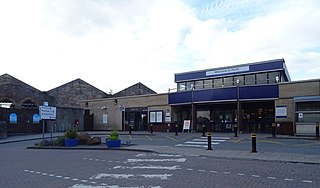
The Caledonian Railway (CR) was a major Scottish railway company. It was formed in the early 19th century with the objective of forming a link between English railways and Glasgow. It progressively extended its network and reached Edinburgh and Aberdeen, with a dense network of branch lines in the area surrounding Glasgow. It was absorbed into the London, Midland and Scottish Railway in 1923. Many of its principal routes are still used, and the original main line between Carlisle and Glasgow is in use as part of the West Coast Main Line railway.

Lockerbie railway station is a railway station serving the town of Lockerbie, on the West Coast Main Line, Dumfries and Galloway, Scotland. It is located 75 miles south of Glasgow Central and 324 miles north of London Euston. The station is owned by Network Rail.

Perth railway station is a railway station located in the city of Perth, Scotland, on both the Glasgow to Dundee line and the Highland Main Line. It is managed by ScotRail, who provide almost all of the services.
The Glasgow, Dumfries and Carlisle Railway was a railway company in Scotland, which constructed the line from near Cumnock to Gretna Junction, forming the route from Glasgow to Carlisle via Dumfries, in association with other lines. Its promoters hoped it would form the only railway between central Scotland and England, but it lost out to rival companies.

The Glasgow South Western Line is a mainline railway in Scotland that runs from Glasgow to Kilmarnock, and then either Carlisle via Dumfries, or Stranraer via Ayr, with a branch to East Kilbride.

Gleneagles railway station serves the town of Auchterarder in Perth and Kinross, Scotland.
The Lochearnhead, St Fillans and Comrie Railway company was formed to build a line along the valley of Strathearn, closing the gap between the Callander and Oban line of the Caledonian Railway and Crieff. Tourism was on the increase in the area, and there were ambitious ideas that imported goods traffic at Oban would be routed to the eastern Scotland towns and cities over the line.
The Perth, Almond Valley and Methven Railway was a Scottish railway line that connected Methven with Perth. It opened in 1858.
The Crieff and Methven Junction Railway was a Scottish railway, opened in 1866, connecting Crieff with a branch line that ran from Methven to Perth.
Muthill railway station served the village of Muthill in Scotland. The station is now the premises of James Haggart & Sons LTD the site also has around 7 houses on it.
The Dunblane, Doune and Callander Railway was opened in 1858 to connect Callander and Doune with the Scottish railway network. When promoters wished to make a connection to Oban, Callander was an obvious place to start, and from 1880 Callander was on the main line to Oban. The railway network was reduced in the 1960s and the line closed in 1965. Oban is now served by a different route.
The Scottish Central Railway was formed in 1845 to link Perth and Stirling to Central Scotland, by building a railway line to join the Edinburgh and Glasgow Railway near Castlecary.
Pittenzie Halt railway station on the Crieff Junction Railway served the small hamlet of Pittachar, near Crieff in Scotland. The line was built in 1856 for the Crieff Junction Railway, which connected Crieff with the Scottish Central Railway at Crieff Junction. The CJR was absorbed by the Caledonian Railway in 1865, which itself became part of the London, Midland and Scottish in 1923. The line and the station were closed as part of the Beeching closures in 1964.

The Aberdeen Railway was a Scottish railway company which built a line from Aberdeen to Forfar and Arbroath, partly by leasing and upgrading an existing railway.
The Forth and Clyde Junction Railway was a railway line in Scotland which ran from Stirling to Balloch.
The Dundee and Arbroath Railway was an early railway in Scotland. It opened in 1838, and used the unusual track gauge of 5 ft 6 in (1,676 mm). In 1848 it changed to standard gauge and connected to the emerging Scottish railway network.
The Dundee and Perth Railway was a Scottish railway company. It opened its line in 1847 from Dundee to a temporary station at Barnhill and extended to Perth station in 1849. It hoped to link with other railways to reach Aberdeen and changed its name to the Dundee and Perth and Aberdeen Railway Junction Company, but this early attempt was frustrated, and for some years it failed to make a physical connection with other railways in Dundee.
The Crieff and Comrie Railway was a Scottish railway, opened in 1893, connecting Comrie to the railway network at Crieff. The tourism potential of Loch Earn was an important factor, and the route was later extended westward to Lochearnhead. However the line was never successful, and declined in the twentieth century, particularly due to cheap and frequent bus competition. Four-wheel railbuses were introduced in 1958 to reduce operating costs, but the decline continued and the line closed on 6 July 1964.
The Rutherglen and Coatbridge Railway was a railway line in Scotland built by the Caledonian Railway to shorten the route from the Coatbridge area to Glasgow. It opened in 1865. It was later extended to Airdrie in 1886, competing with the rival North British Railway. Soon after a further extension was built from Airdrie to Calderbank and Newhouse.
The Glasgow, Bothwell, Hamilton and Coatbridge Railway was a railway company in Scotland, built to serve coal and ironstone pits in the Hamilton and Bothwell areas, and convey the mineral to Glasgow and to ironworks in the Coatbridge area. It was allied to the North British Railway, and it opened in 1877. Passenger services followed.






